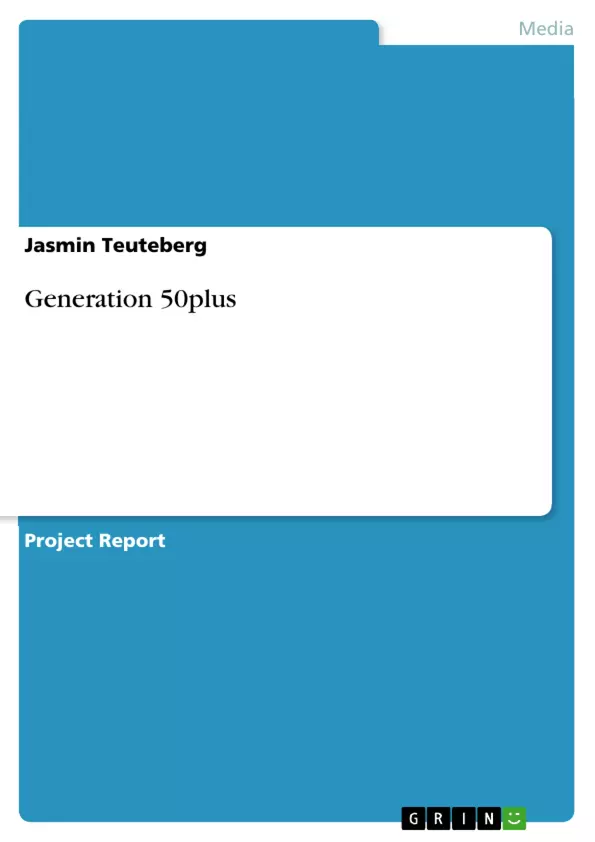The research question I am interested in is concerned to the generation 50plus: How is the generation 50plus perceived in German social magazines and to what extend are their needs served by the published ads in those magazines, i.e. how is the generation 50plus addressed by the (advertising) industry? I have chosen this topic, since it is of a current importance in the discussion of media target groups beyond the border of the standardized definition of the alleged relevant target group for advertisers in the age of 1449 years. Especially the 50- to 64-year age group is more brand than price orientated. That means they have no problem to pay more for higher quality, to expand more for fashion, cosmetics and luxury articles, to wine and dine and to go out to theatres, cinemas or concerts quite often. It is estimated that the generation 50plus (also called »Best Ager«) has a spending power about the half of the purchasing power potential in Germany circa 90 billion Euros and an above-averaged propensity to consume. Therefore their spending power is four times higher than that of average households. Furthermore nowadays the target group of the generation 50plus spans already 30 billion citizens in Germany. The share of the Best Ager of all Germans will increase from currently 37 percent to 50 percent by 2050. These data clarify why »the aged« became to a central economic factor in Germany (but for example also in USA and UK, where their relevance and potential has been recognized some years earlier) and claims for a rethinking in marketing strategies. To investigate the research question I am going to combine a qualitative and quantitative method discourse analysis and content analysis. I will use the discourse analysis to study how the generation 50plus is described in previous articles (i.e. from older issues) in German social magazines (Focus, Der Spiegel etc.) and with what meanings, needs and values is it connoted. If necessary, I will translate the analysed articles in English, but one should be conscious of the possibility, that a deeper meaning can get lost with the translation. The content analysis is used to study whether the needs and values of the generation 50plus are served by ads from those magazines I have analysed already before with the discourse analysis, i.e. ads in above mentioned social magazines. For this I will use one current issue per magazine and analyse all represented ads.
Inhaltsverzeichnis (Table of Contents)
- Introduction
- Methods
- Discourse Analysis
- Content Analysis
- Applications of Methods and Analysis
- Discourse Analysis
- Results Discourse Analysis
- Content Analysis
- Results Content Analysis
- Discourse Analysis
- General results in consideration of both methods and research question
- Conclusion
- Bibliography
- Appendix
- Discourse Analysis of articles
- Article DER SPIEGEL
- Article stern
- Article FOCUS
- Code book
- Coding scheme
- Links to articles
- Discourse Analysis of articles
Zielsetzung und Themenschwerpunkte (Objectives and Key Themes)
The primary goal of this project is to investigate the representation of the generation 50plus in German social magazines and evaluate the extent to which advertising in these magazines caters to the needs of this demographic. The study focuses on how the generation 50plus is portrayed and addressed within a media landscape traditionally geared toward a younger target audience. Key themes explored in this project include:- The changing demographics of Germany and the growing importance of the generation 50plus as a consumer group.
- The perception and representation of the generation 50plus in German social magazines.
- The marketing strategies used to reach and engage this demographic.
- The effectiveness of these strategies in meeting the needs and preferences of the generation 50plus.
Zusammenfassung der Kapitel (Chapter Summaries)
This section provides a summary of the chapters in the research report, excluding the conclusion and final chapter.- Introduction: This chapter outlines the current demographic trends in Germany, highlighting the increasing prominence of the generation 50plus. It emphasizes the growing economic significance of this demographic due to their above-average spending power and consumption patterns, emphasizing the need for a re-evaluation of marketing strategies.
- Methods: This chapter details the research methodology employed in the study, combining discourse analysis and content analysis. It explains how discourse analysis will be utilized to examine the portrayal of the generation 50plus in German social magazines, while content analysis will investigate the extent to which advertisements in these magazines cater to their needs.
- Applications of Methods and Analysis: This chapter outlines the specific application of both discourse analysis and content analysis to the research question. It details the process of analyzing articles from older issues of German social magazines to understand the prevalent narratives about the generation 50plus, while also analyzing advertisements from current issues of those same magazines.
- General results in consideration of both methods and research question: This chapter combines the findings of both discourse analysis and content analysis to provide a comprehensive understanding of the representation of the generation 50plus in German social magazines and its relationship to the advertising strategies targeting this demographic.
Schlüsselwörter (Keywords)
The research focuses on the generation 50plus, often referred to as "Best Ager," as a significant consumer group in Germany. The project explores their representation in German social magazines and the effectiveness of marketing strategies targeted at this demographic. Key concepts include: media target groups, discourse analysis, content analysis, marketing strategies, consumer behavior, and demographic change.- Quote paper
- B.A. Jasmin Teuteberg (Author), 2008, Generation 50plus, Munich, GRIN Verlag, https://www.grin.com/document/117523



